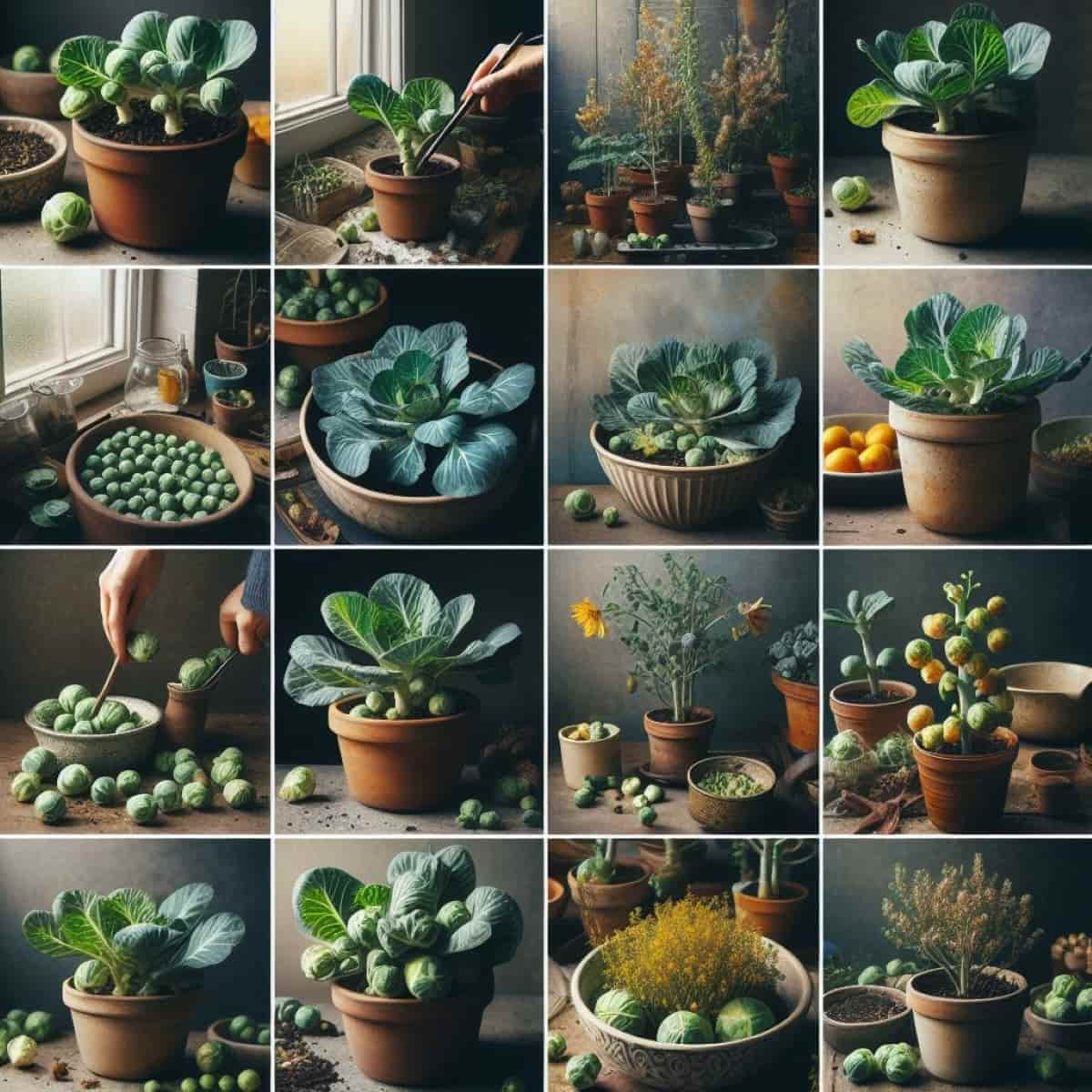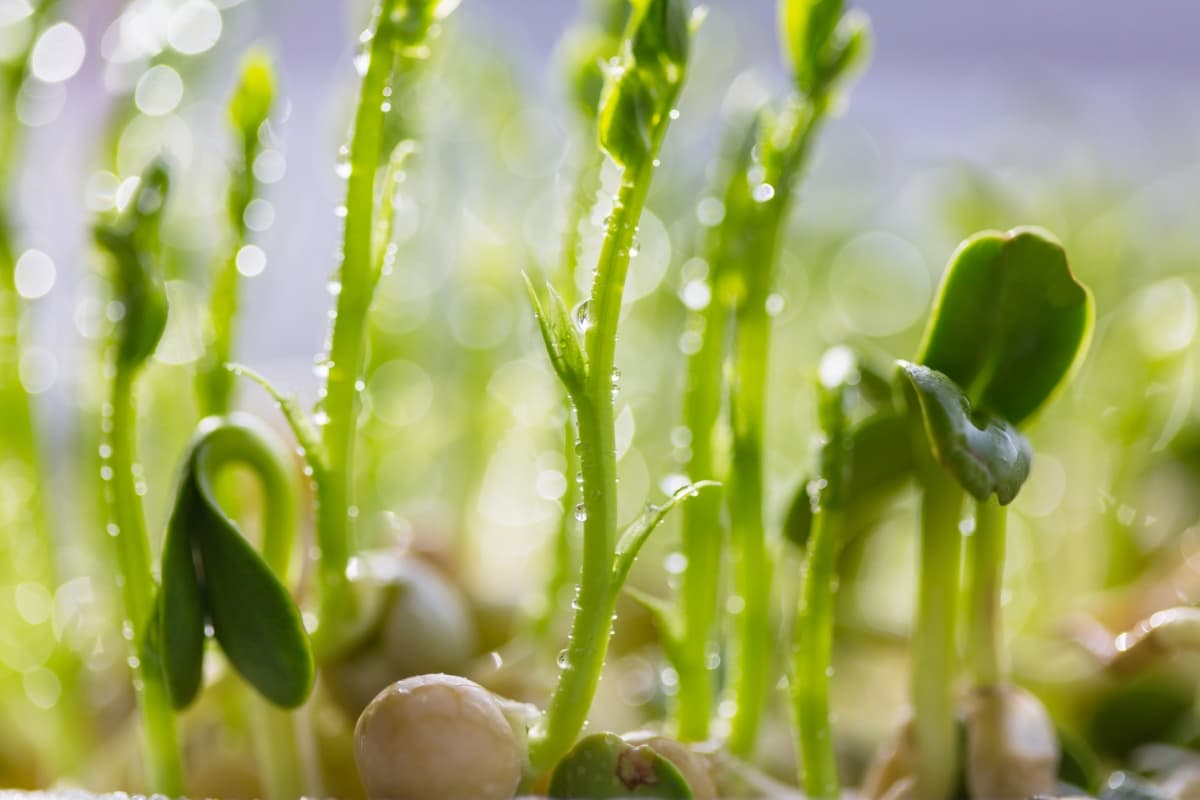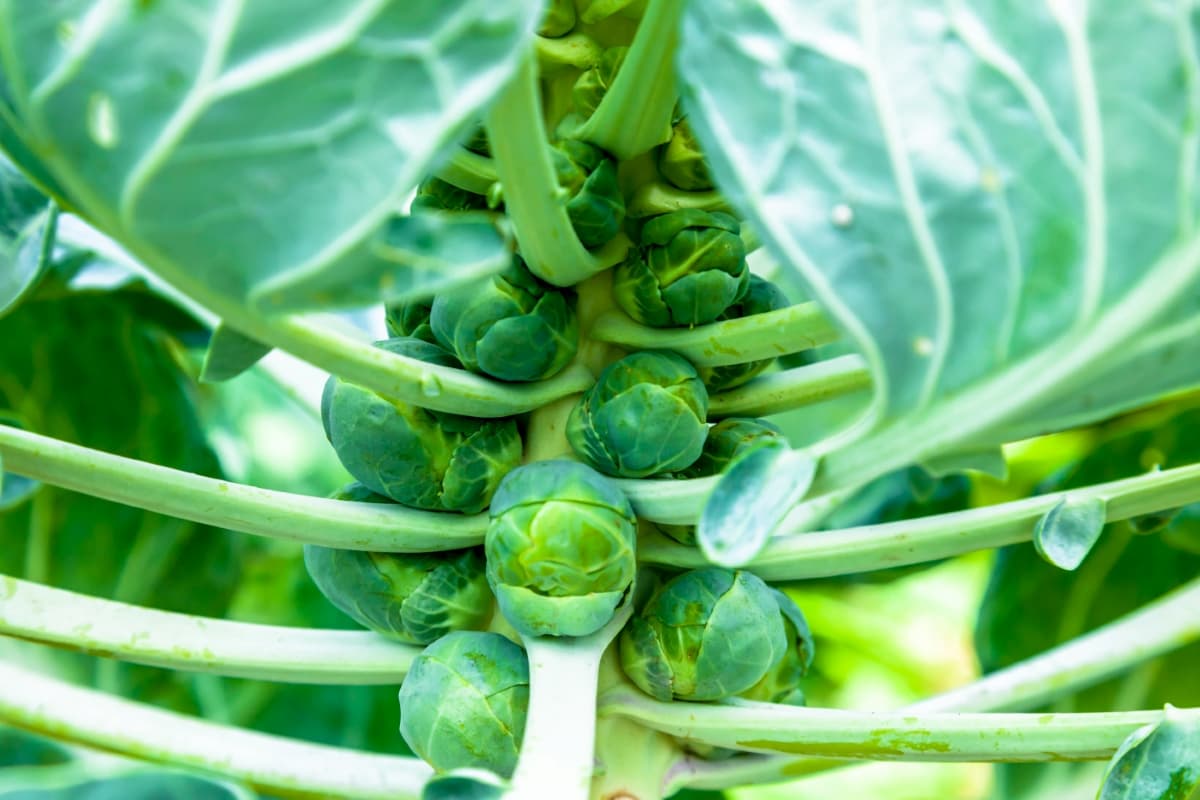Container gardening offers a flexible and convenient way to grow Brussels sprouts, allowing gardeners to cultivate these nutritious vegetables in small spaces or urban environments. This extensive guide encompasses all aspects, ranging from choosing the appropriate container and soil to handling pest issues and ensuring the survival of your plants during the winter months.

Container Grown Brussels Sprouts
Understanding Container-Grown Brussels Sprouts
Growing Brussels sprouts in containers is rewarding for gardeners with limited space or who prefer container gardening. Understanding container-grown Brussels sprouts involves knowing how to grow Brussels sprouts in a container, whether you can grow Brussels sprouts inside, and if growing them in a grow bag is feasible.
The brussels sprouts growing stages are crucial to comprehend, especially how tall Brussels sprouts grow and how many Brussels sprouts per plant you can expect. This guide provides detailed insights into each aspect of growing Brussels sprouts in containers, ensuring that even those new to gardening can confidently embark on this journey.
Select the Right Container for Brussels Sprouts
Size and material are key considerations when choosing a container for Brussels sprouts. A large container, at least 12-24 inches in depth and width, is ideal since Brussels sprouts need room for their roots to expand. A wider container can accommodate multiple plants, considering Brussels sprouts can grow quite tall, often reaching heights over 2 feet.
Drainage is critical; thus, containers with drainage holes are essential to prevent waterlogging. You can use various materials, from plastic to clay or ceramic, but remember that each material impacts soil moisture and temperature differently. Lightweight containers are preferable if you plan to move your plants around to capture sunlight optimally.
Choose the Ideal Potting Mix
For container-grown Brussels sprouts, selecting the right potting mix is essential. A high-quality, well-draining potting soil ensures the right balance of moisture and air for the roots. A mix that includes compost will provide essential nutrients, aiding in the healthy growth of the plants. Since Brussels sprouts are heavy feeders, a potting mix enriched with organic matter is beneficial. The ideal potting mix should hold moisture and drain well enough to prevent root rot, providing a healthy environment for the Brussels sprouts to thrive through their growth stages.
Planting Brussels Sprouts Seeds in Containers
Planting Brussels sprouts seeds in containers is straightforward but requires attention to detail. Begin by placing potting mix into your selected container, ensuring there is approximately one inch of space remaining at the top. Sow the seeds about ½ inch deep and cover them lightly with soil. Space the seeds or seedlings about 18-24 inches apart, as Brussels sprouts need room to spread out as they grow.
In case you missed it: How to Prepare the Soil and Plant Brussels Sprouts

If you’re starting with seedlings, ensure they are hardened off before transplanting to avoid shock. The initial growth stage is crucial, so keep the soil consistently moist but not waterlogged. Thinning the seedlings once they have a few leaves ensures that only the strongest plants are left to grow to maturity.
Provide Adequate Sunlight
Brussels sprouts require adequate sunlight to grow well in containers. For optimal growth, Brussels sprouts require ample sunlight, ideally 6-8 hours of direct sunlight every day. If you’re cultivating Brussels sprouts indoors, position them near a sunlit window, or employ grow lights to compensate for the absence of natural sunlight.
If your outdoor space does not receive enough sunlight, consider using a plant caddy to move the container to sunnier spots throughout the day. Remember, too little sunlight can lead to spindly plants and poor development of the sprouts, so consistent exposure to sunlight is crucial for a healthy harvest.
Watering Techniques for Container-Grown Brussels Sprouts
Watering container-grown Brussels sprouts correctly is vital for their growth. The goal is to keep the soil moist but not overly wet, as waterlogging can lead to root diseases. Typically, a deep watering once or twice a week is sufficient, but more frequent watering may be required during hotter days. Check the top inch of the soil for dryness to determine if watering is needed. Regular, consistent watering helps develop well-formed sprouts and ensures overall plant health.
Fertilize Container-Grown Brussels Sprouts
Fertilizing is crucial for the growth and development of Brussels sprouts in containers. Regular feeding is necessary since nutrients can quickly leach out of the potting mix. Apply a well-balanced, water-soluble fertilizer every 4 to 6 weeks, beginning when the plants reach approximately 6 inches in height. It’s generally advisable to use a fertilizer with an NPK (nitrogen, phosphorus, potassium) ratio of 10-10-10. However, exercise care when using fertilizers with high nitrogen levels, as they may encourage leaf growth at the cost of the budding process.
Alternatively, you can opt for organic fertilizers such as compost tea or fish emulsion, which also supply the essential nutrients. It’s important to follow the instructions on the fertilizer package to avoid over-fertilizing, which can harm the plants. Proper fertilization ensures the Brussels sprouts receive all the nutrients they need for each growth stage, leading to a bountiful and healthy harvest.
Manage Pests and Diseases in Container-Grown Brussels Sprouts
Managing pests and diseases is essential to growing Brussels sprouts in containers. Regular monitoring helps in early detection and control of common pests like aphids, caterpillars, and slugs. Using natural treatments, such as neem oil or insecticidal soap, can prove to be quite efficient in addressing these pests. It’s important to be vigilant for ailments like powdery mildew or leaf spot.
In case you missed it: Utilizing Cover Crops in Brussels Sprouts Farming Systems

Good air circulation, proper spacing, and avoiding overhead watering can help prevent these diseases. If any plants become severely affected, it’s better to remove them to prevent the spread to healthy plants. Hygiene is crucial; clean your containers and tools regularly. By staying vigilant and treating problems early, you can keep your Brussels sprouts healthy and thriving.
Support Container-Grown Brussels Sprouts
As Brussels sprouts grow, they may require support to prevent them from toppling over, especially in containers. Tall varieties, in particular, can get quite heavy and unbalanced. You can use stakes or cages to provide support. Gently place the stakes into the pot, being mindful not to harm the roots, and then loosely secure the plant to the stake using gentle ties.
This support is particularly important as the sprouts form and weigh down the stalks. Regularly adjust ties as the plant grows. Providing support helps maintain the plant’s upright position and ensures better air circulation around the plant, reducing the risk of diseases.
Prune Brussels Sprouts in Containers
Pruning is a key part of caring for Brussels sprouts grown in containers. It encourages larger, more uniform sprouts and helps in maintaining plant health. Remove the plant’s lower leaves as it grows, especially any that look yellow or damaged. This process improves air circulation and reduces the risk of soil-borne diseases.
As the sprouts start forming, consider removing the top of the plant (topping) to encourage the development of the sprouts lower down the stalk. This topping should be done when the lower sprouts are beginning. Pruning not only aids in better sprout development but also directs the plant’s energy to produce sprouts rather than leaves.
Overwinter the Brussels Sprouts in Containers
Overwintering Brussels sprouts in containers can extend your harvest into the colder months. Brussels sprouts are hardy plants and can tolerate frost, which often improves their flavor. If you live in an area with severe winters, consider moving the containers to a sheltered spot, like against a south-facing wall or under a porch, to protect them from harsh conditions.
In case you missed it: Best Practices to Increase Brussels Sprouts Yield: Simple Techniques for High Production

Mulching the top of the container with straw or leaves can provide extra insulation. If the temperatures dip below freezing for prolonged periods, you might need to provide additional protection, such as a frost cloth. You can enjoy fresh sprouts by successfully overwintering your Brussels sprouts throughout the winter months.
Conclusion
Successfully growing Brussels sprouts in containers is a rewarding experience that combines the joys of gardening with the pleasure of harvesting fresh, healthy produce.
- Feed Your Flock for Less: Top 10 Tips to Save on Chicken Feed
- Ultimate Guide to Ossabaw Island Hog: Breeding, Raising, Diet, and Care
- Hatching Answers: The Top 10 Reasons Your Chickens Aren’t Laying Eggs
- Eggs and Economics: Breaking Down the Cost of Raising Backyard Chickens
- Defend Your Greens: Proven Methods to Keep Iguanas Out of Your Garden
- Ultimate Guide to Cinnamon Queen Chicken: A Comprehensive Guide for Beginners
- Ultimate Guide to California Tan Chicken: Breeding, Raising, Diet, Egg-Production and Care
- Ultimate Guide to Marsh Daisy Chicken: Breeding, Raising, Diet, and Care
- 10 Types of Chicken Farming Businesses You Can Start for Profits